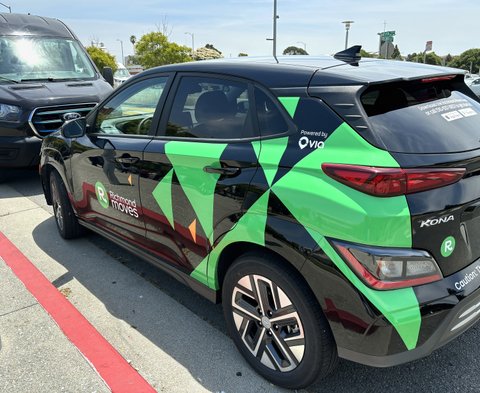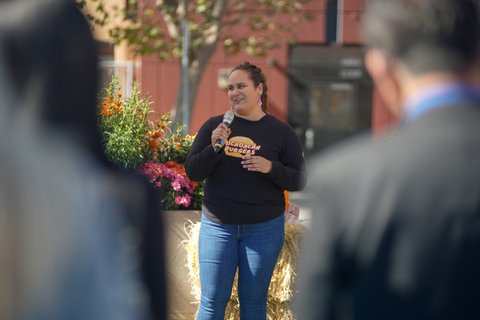
20 Jun Richmond Expands Rideshare Program, Hoping to Drive Commuters to Nearby Transit Hubs

A ‘Richmond Moves’ vehicle is parked at the Richmond Civic Center Plaza on Tuesday at an event celebrating the citywide expansion of the city’s electric, on-demand, app-based public transit program that launched in April 2022. (Cole Reynolds / Bay City News)
By Cole Reynolds
Bay City News
Everyone and everything was ready to cut the ribbon on Richmond’s expansion to its rideshare program on Tuesday afternoon. Everything except the scissors in Richmond Vice Mayor Claudia Jimenez’s hands.
She gave them a squeeze, then a few more for good measure, but they refused to slice through the red ribbon, to the amusement of the small crowd gathered to watch.
A staffer fetched a new pair, and the ribbon finally fell in front of green and black electric cars parked in the background. They represented the city’s latest push to electrify and expand its “Richmond Moves” program.
“We are paving the way for a greener, more connected Richmond,” Jimenez said.
>>>From Our Archives: City Works to Expand Electric Vehicle Use, Reacts to Roe v. Wade News<<<
Through the program, people can order a $2 ride between any two locations in Richmond, administered by tech company Via Transportation. The city rolled out the program in 2022 in a roughly 5-mile area before extending the service almost citywide in April.
Since 2022, the service delivered roughly 75,000 rides, according to Joe Martin, director of partner success with Via. And after the expansion took effect in April, weekly rides have doubled, Martin told the crowd on Tuesday.
“We are really excited to, with this expansion, provide more rides to more residents throughout the city of Richmond,” Martin said.
This type of publicly supported rideshare, known as “microtransit,” has been growing in popularity across the country. Via now services more than 700 cities nationwide, Martin told attendees at the event in Richmond. It has been particularly a hit for smaller cities looking to connect riders with other forms of transit.
>>>Read: East County Hopes On-Demand Driverless Cars Will Help With Commute<<<
The service targets commuters, running just on weekdays between 7 a.m. and 7 p.m. in Richmond. According to Martin, it is designed to shepherd riders to other public transit options like the ferry or train stations.
And Richmond riders seem to use it for this purpose. Data shared by Via shows that the most frequent destination for riders is the Richmond BART stop.
“The program is really focused on that first mile, last mile use case and making sure we are helping people connect to transit,” Martin said.
Getting riders to public transit is a concern amongst transit agencies, particularly in cities like Richmond, which is served by a single BART stop and just nine local Alameda-Contra Costa Transit bus lines.
“A challenge for the state is how do we have public transportation that really gets to all the needs of the community,” Jimenez said.
Despite the expansion, not every Richmond resident has access to the service. Portions of the city’s District 4 remain uncovered by the program. It is a more rural slice of the city toward El Sobrante, which includes Richmond resident Harry Wiener’s home.
A retiree, Wiener said he doesn’t have much use for the service to commute. But his daughter recently welcomed a baby, and Wiener said that he often visits them in New York City. He imagines himself taking a Via to a BART station to begin one of his journeys to New York.
While Via’s rideshare provides limited use to Wiener, he asked Jimenez to consider expanding service further into District 4 after Tuesday’s event.
“We have a lot of people who are not well off who could use it for their commutes,” Wiener said.
Martin said expanding service to this area would take more funding, but Via was in negotiations with Richmond to do so.
But speakers at Tuesday’s event stressed that Via simply plays one role in a larger transit system. And Jimenez said that fully servicing Richmond requires change at the state level, too.
“It cannot be just regional,” Jimenez said. “If the state really wants to reduce emissions, there need to be a massive investment in public transit in every single (system).”
Copyright © 2024 Bay City News, Inc. All rights reserved. Republication, rebroadcast or redistribution without the express written consent of Bay City News, Inc. is prohibited. Bay City News is a 24/7 news service covering the greater Bay Area.






No Comments